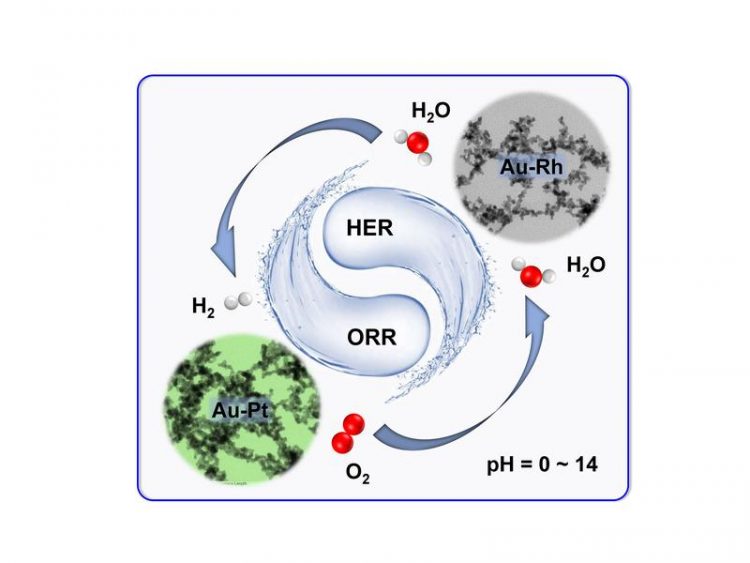TU Dresden chemists develop noble metal aerogels for electrochemical hydrogen production and other applications

New-type noble metal aerogels were developed for outstanding pH-universal electrocatalysis toward hydrogen evolution reaction and oxygen reduction reaction. Wiley-VCH
Electrocatalysis is one of the most studied topics in the field of material science, because it is extensively involved in many important energy-related processes, such as the oxygen reduction reaction (ORR) for fuel cells, the hydrogen evolution reaction (HER) for green hydrogen production, and the oxygen evolution reaction (OER) for metal-air batteries.
Noble metal aerogels (NMAs) emerge as a new class of outstanding electrocatalysts due to the combined feature of metals and aerogels. However, limited by the available compositions, the explored electrocatalytic reactions on NMAs are highly restricted and certain important electrochemical processes have not been investigated.
Ran Du from China is a Alexander von Humboldt research fellow working as postdoc in the physical chemistry group of Professor Alexander Eychmüller at TU Dresden since 2017.
In collaboration with Prof. Wei Jin from the Jiangnan University, China, they recently created various noble metal aerogels, disclosing their unprecedented potential for diverse pH-universal electrochemical catalysis, including oxygen reduction reaction (ORR), hydrogen evolution reaction (HER), and electrochemical water splitting.
These findings largely span the application territory of NMAs for fuel cells, green hydrogen production and many more. The work was published in the renowned journal Advanced Energy Materials.
By adopting a strong salting-out agent (i.e. ammonium fluoride (NH4F)) as an initiator to trigger gelation, the composition of the as-obtained noble metal aerogels (NMAs) was extended to various bi- and trimetallic systems. Subsequently Ran Du and his team manipulated the chemical composition, and thus expanding the application territory of NMAs to pH-universal ORR electrocatalysis, HER electrocatalysis, and electrochemical water splitting.
Notably, the Au-Rh aerogel and Au-Pt aerogel manifested extraordinary pH-universal performance for HER and ORR electrocatalysis, respectively, both of which considerably outperform commercial Pt/C (platinum on carbon) in wide pH environments.
“Further research directions may be placed on morphology-controlled NMA synthesis, and the establishment of the correlations between the structural features of NMAs and their electrocatalytic properties,” assumes chemist Ran Du.
Media inquiries:
Nicole Gierig
Public Relations Advisor
School of Science
TU Dresden
Email: Nicole.gierig@tu-dresden.de
Du, R.; Jin, W.*; Hübner, R.; Zhou, L.; Hu, Y.; Eychmüller, A.*, Engineering Multimetallic Aerogels for pH-Universal HER and ORR Electrocatalysis. Adv. Energy Matter. 2020, DOI: 10.1002/aenm.201903857.
Media Contact
More Information:
http://www.tu-dresden.deAll latest news from the category: Life Sciences and Chemistry
Articles and reports from the Life Sciences and chemistry area deal with applied and basic research into modern biology, chemistry and human medicine.
Valuable information can be found on a range of life sciences fields including bacteriology, biochemistry, bionics, bioinformatics, biophysics, biotechnology, genetics, geobotany, human biology, marine biology, microbiology, molecular biology, cellular biology, zoology, bioinorganic chemistry, microchemistry and environmental chemistry.
Newest articles

Properties of new materials for microchips
… can now be measured well. Reseachers of Delft University of Technology demonstrated measuring performance properties of ultrathin silicon membranes. Making ever smaller and more powerful chips requires new ultrathin…

Floating solar’s potential
… to support sustainable development by addressing climate, water, and energy goals holistically. A new study published this week in Nature Energy raises the potential for floating solar photovoltaics (FPV)…

Skyrmions move at record speeds
… a step towards the computing of the future. An international research team led by scientists from the CNRS1 has discovered that the magnetic nanobubbles2 known as skyrmions can be…





















